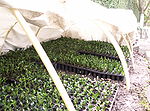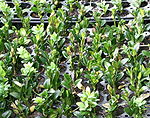
Striking
Encyclopedia

Vegetative reproduction
Vegetative reproduction is a form of asexual reproduction in plants. It is a process by which new individuals arise without production of seeds or spores...
(asexually) propagating plants
Plant propagation
Plant propagation is the process of creating new plants from a variety of sources: seeds, cuttings, bulbs and other plant parts. Plant propagation can also refer to the artificial or natural dispersal of plants.-Sexual propagation :...
in which a piece of the source plant containing at least one stem cell is placed in a suitable medium such as moist soil
Soil
Soil is a natural body consisting of layers of mineral constituents of variable thicknesses, which differ from the parent materials in their morphological, physical, chemical, and mineralogical characteristics...
, potting mix, coir
Coir
Coir is a natural fibre extracted from the husk of coconut and used in products such as floor mats, doormats, brushes, mattresses etc. Technically coir is the fibrous material found between the hard, internal shell and the outer coat of a coconut. Other uses of brown coir are in upholstery...
or rock wool. The cutting produces new root
Root
In vascular plants, the root is the organ of a plant that typically lies below the surface of the soil. This is not always the case, however, since a root can also be aerial or aerating . Furthermore, a stem normally occurring below ground is not exceptional either...
s, stem
Plant stem
A stem is one of two main structural axes of a vascular plant. The stem is normally divided into nodes and internodes, the nodes hold buds which grow into one or more leaves, inflorescence , conifer cones, roots, other stems etc. The internodes distance one node from another...
s, or both, and thus becomes a new plant independent of the parent.
Technique
Typically, striking is a simple process in which a small amount of the parent plant is removed. This removed piece, called the cutting, is then encouraged to grow as an independent plant.Since most plant cuttings will have no root system of their own, they are likely to die from dehydration if the proper conditions are not met.
They require a moist medium, which, however, cannot be too wet lest the cutting rot. A number of media are used in this process, including but not limited to soil, perlite
Perlite
Perlite is an amorphous volcanic glass that has a relatively high water content, typically formed by the hydration of obsidian. It occurs naturally and has the unusual property of greatly expanding when heated sufficiently...
, vermiculite
Vermiculite
Vermiculite is a natural mineral that expands with the application of heat. The expansion process is called exfoliation and it is routinely accomplished in purpose-designed commercial furnaces. Vermiculite is formed by weathering or hydrothermal alteration of biotite or phlogopite...
, coir
Coir
Coir is a natural fibre extracted from the husk of coconut and used in products such as floor mats, doormats, brushes, mattresses etc. Technically coir is the fibrous material found between the hard, internal shell and the outer coat of a coconut. Other uses of brown coir are in upholstery...
, rock wool
Mineral wool
Mineral wool, mineral fibers or man-made mineral fibers are fibers made from natural or synthetic minerals or metal oxides. The latter term is generally used to refer solely to synthetic materials including fiberglass, ceramic fibers and stone wool...
, expanded clay, and even water given the right conditions.
The environment should be humid (this generally means placing the cuttings under a plastic sheet or in another confined space where the air can be kept moist)
and partial shade should be provided, also to prevent the cutting from drying out. After cuttings are placed in the medium, they are watered thoroughly with a fine mist, such as from a nozzle sprayer or a spray mister bottle. After the initial watering, the medium is allowed to almost dry out before misting again, with the aim to keep the soil moist but not wet and waterlogged. A fine mist is used to avoid disturbing plants.
In addition, the cutting needs to be taken correctly.
It must be taken at the right time; in temperate countries, stem cuttings of young wood need to be taken in spring, of hardened wood they need to be taken in winter.
It must have the right size and amount of foliage; length of stem cuttings of soft wood for example need to be between 5-15 cm and of hard wood between 20-25 cm. Also, two thirds of the foliage of soft wood stem cuttings should be removed. For hard wood stem cuttings, complete foliage removal is necessary.
If the plant is unlikely to grow then a rooting hormone to "encourage" the plant to grow and mature may be administered.
Though not essential, several compounds may be used to promote the formation of roots through the signaling activity of plant hormone
Plant hormone
Plant hormones are chemicals that regulate plant growth, which, in the UK, are termed 'plant growth substances'. Plant hormones are signal molecules produced within the plant, and occur in extremely low concentrations. Hormones regulate cellular processes in targeted cells locally and, when moved...
auxins, and is helpful with especially hard plant species. Among the commonly used chemicals is indole-3-butyric acid
Indole-3-butyric acid
Indole-3-butyric acid is a white to light-yellow crystalline solid, with the molecular formula C12H13NO2. It melts at 125 °C in atmospheric pressure and decomposes before boiling.-Plant hormone:...
(IBA) used as a powder, liquid solution or gel. This compound is applied either to the cut tip of the cutting or as a foliar spray. Rooting hormone can be manufactured naturally - one method is to soak the yellow-tipped shoots of a weeping willow tree in water, or to prepare a tea
Tea
Tea is an aromatic beverage prepared by adding cured leaves of the Camellia sinensis plant to hot water. The term also refers to the plant itself. After water, tea is the most widely consumed beverage in the world...
from the bark of a willow tree. When using the shoots or bark, they should be soaked for 24 hours prior to using. Honey
Honey
Honey is a sweet food made by bees using nectar from flowers. The variety produced by honey bees is the one most commonly referred to and is the type of honey collected by beekeepers and consumed by humans...
, though it does not contain any plant hormones, can also make an effective rooting substance.
Some plants form roots much more easily. Most succulent cuttings can be left on a table and small roots will form, and some other plants can form roots from having their cuttings placed in a cup of water.
Types of cuttings
Many vegetative parts of a plant can be used. The most common methods are:-- Stem cuttings, in which a piece of stem is part buried in the soil, including at least one leaf node. The cutting is able to produce new roots, usually at the node.
- Root cuttings, in which a section of root is buried just below the soil surface, and produces new shoots
- Scion cuttings, which are dormant ligneous woody twigs.
- Eye cuttings, which are pieces of foliated or defoliated stalks with one or more eyes.
- Leaf cuttings, in which a leaf is placed on moist soil. These have to develop both new stems and new roots. Some leaves will produce one plant at the base of the leaf. In some species, multiple new plants can be produced at many places on one leaf, and these can be induced by cutting the leaf veins.
Although some species, such as willow
Willow
Willows, sallows, and osiers form the genus Salix, around 400 species of deciduous trees and shrubs, found primarily on moist soils in cold and temperate regions of the Northern Hemisphere...
, blackberry
Blackberry
The blackberry is an edible fruit produced by any of several species in the Rubus genus of the Rosaceae family. The fruit is not a true berry; botanically it is termed an aggregate fruit, composed of small drupelets. The plants typically have biennial canes and perennial roots. Blackberries and...
and pelargonium
Pelargonium
Pelargonium is a genus of flowering plants which includes about 200 species of perennials, succulents, and shrubs, commonly known as scented geraniums or storksbills. Confusingly, Geranium is the correct botanical name of a separate genus of related plants often called Cranesbills. Both Geranium...
s can be grown simply by placing a cutting into moist ground, the majority of species require more attention. Most species require humid, warm, partially shaded conditions to strike, thus requiring the approach above to be followed. Particularly difficult species may need cool air above and warm soil. In addition, with many more difficult cuttings, one should use the type of cutting that has the most chance of success with that particular plant species.
Providing the right soil
Depending on the type of soil being used, several additives may need adding to create good soil for cuttings. These additions may include:- chalk; to increase the pHPHIn chemistry, pH is a measure of the acidity or basicity of an aqueous solution. Pure water is said to be neutral, with a pH close to 7.0 at . Solutions with a pH less than 7 are said to be acidic and solutions with a pH greater than 7 are basic or alkaline...
-value of the soil; a pH of 6-6,5 is to be maintained - organic substance/humus; to increase nutrient load; keep to a bare minimum though
- sand or gravel; to increase the soil's water permeability
For example with plain potting soil, a third of the container should be filled with sand, to make suitable soil for cuttings.
Providing the right humidity

Mold
Molds are fungi that grow in the form of multicellular filaments called hyphae. Molds are not considered to be microbes but microscopic fungi that grow as single cells called yeasts...
s.
Stem cuttings or truncheons

Bushel
A bushel is an imperial and U.S. customary unit of dry volume, equivalent in each of these systems to 4 pecks or 8 gallons. It is used for volumes of dry commodities , most often in agriculture...
).

